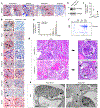Non-canonical Wnt/calcium signaling is protective against podocyte injury and glomerulosclerosis
- PMID: 35341792
- PMCID: PMC9232939
- DOI: 10.1016/j.kint.2022.02.029
Non-canonical Wnt/calcium signaling is protective against podocyte injury and glomerulosclerosis
Abstract
Activation of canonical Wnt signaling has been implicated in podocyte injury and proteinuria. As Wnts are secreted proteins, whether Wnts derived from podocytes are obligatory for promoting proteinuria remains unknown. To address this, we generated conditional knockout mice where Wntless, a cargo receptor protein required for Wnt secretion, was specifically deleted in glomerular podocytes. Mice with podocyte-specific ablation of Wntless (Podo-Wntless-/-) were phenotypically normal. However, after inducing kidney damage with Adriamycin for six days, Podo-Wntless-/- mice developed more severe podocyte injury and albuminuria than their control littermates. Surprisingly, ablation of Wntless resulted in upregulation of β-catenin, accompanied by reduction of nephrin, podocin, podocalyxin, and Wilms tumor 1 proteins. In chronic injury induced by Adriamycin, increased albuminuria, aggravated podocyte lesions and extracellular matrix deposition were evident in Podo-Wntlessl-/- mice, compared to wild type mice. Mechanistically, specific ablation of Wntless in podocytes caused down-regulation of the nuclear factor of activated T cell 1 (NFAT1) and Nemo-like kinase (NLK), key downstream mediators of non-canonical Wnt/calcium signaling. In vitro, knockdown of either NFAT1 or NLK induced β-catenin activation while overexpression of NLK significantly repressed β-catenin induction and largely preserved nephrin in glomerular podocytes. Thus, our results indicate that podocyte-derived Wnts play an important role in protecting podocytes from injury by repressing β-catenin via activating non-canonical Wnt/calcium signaling.
Keywords: Wnt signaling; Wntless; glomerulosclerosis; nemo-like kinase; nuclear factor of activated T cell; podocytes; proteinuria.
Copyright © 2022 International Society of Nephrology. Published by Elsevier Inc. All rights reserved.
Conflict of interest statement
DISCLOSURE
All the authors declared no competing interests.
Figures





Similar articles
-
Hepatocyte growth factor signaling ameliorates podocyte injury and proteinuria.Kidney Int. 2010 Jun;77(11):962-73. doi: 10.1038/ki.2010.40. Epub 2010 Mar 10. Kidney Int. 2010. PMID: 20375988 Free PMC article.
-
Wnt/beta-catenin signaling promotes podocyte dysfunction and albuminuria.J Am Soc Nephrol. 2009 Sep;20(9):1997-2008. doi: 10.1681/ASN.2009010019. Epub 2009 Jul 23. J Am Soc Nephrol. 2009. PMID: 19628668 Free PMC article.
-
Wnt/β-catenin links oxidative stress to podocyte injury and proteinuria.Kidney Int. 2019 Apr;95(4):830-845. doi: 10.1016/j.kint.2018.10.032. Epub 2019 Feb 12. Kidney Int. 2019. PMID: 30770219 Free PMC article.
-
Wnt/β-catenin signalling and podocyte dysfunction in proteinuric kidney disease.Nat Rev Nephrol. 2015 Sep;11(9):535-45. doi: 10.1038/nrneph.2015.88. Epub 2015 Jun 9. Nat Rev Nephrol. 2015. PMID: 26055352 Free PMC article. Review.
-
The pathogenic role of Notch activation in podocytes.Nephron Exp Nephrol. 2009;111(4):e73-9. doi: 10.1159/000209207. Epub 2009 Mar 17. Nephron Exp Nephrol. 2009. PMID: 19293596 Free PMC article. Review.
Cited by
-
Molecular mechanisms and therapeutic potential of natural flavonoids in diabetic nephropathy: Modulation of intracellular developmental signaling pathways.Curr Res Pharmacol Drug Discov. 2024 Jul 3;7:100194. doi: 10.1016/j.crphar.2024.100194. eCollection 2024. Curr Res Pharmacol Drug Discov. 2024. PMID: 39071051 Free PMC article. Review.
-
Inhibition of M2 tumor-associated macrophages polarization by modulating the Wnt/β-catenin pathway as a possible liver cancer therapy method.World J Gastroenterol. 2024 Oct 28;30(40):4399-4403. doi: 10.3748/wjg.v30.i40.4399. World J Gastroenterol. 2024. PMID: 39494099 Free PMC article.
-
Mechanisms of inflammation modulation by different immune cells in hypertensive nephropathy.Front Immunol. 2024 Mar 13;15:1333170. doi: 10.3389/fimmu.2024.1333170. eCollection 2024. Front Immunol. 2024. PMID: 38545112 Free PMC article. Review.
-
Calponin 2 harnesses metabolic reprogramming to determine kidney fibrosis.Mol Metab. 2023 May;71:101712. doi: 10.1016/j.molmet.2023.101712. Epub 2023 Mar 22. Mol Metab. 2023. PMID: 36963615 Free PMC article.
-
Fibroblast activation and heterogeneity in fibrotic disease.Nat Rev Nephrol. 2025 Sep;21(9):613-632. doi: 10.1038/s41581-025-00969-8. Epub 2025 Jun 19. Nat Rev Nephrol. 2025. PMID: 40537561 Review.
References
-
- Torban E, et al. From podocyte biology to novel cures for glomerular disease. Kidney Int 96, 850–861 (2019). - PubMed
Publication types
MeSH terms
Substances
Grants and funding
LinkOut - more resources
Full Text Sources
Medical
Research Materials
Miscellaneous

